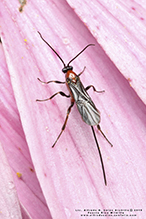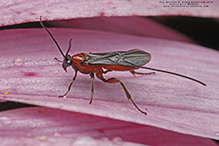braconid wasps
(subfamily Agathidinae)
Overview • Description • Distribution • Taxonomy
Agathidinae prey on caterpillars of moths and butterflies. The female injects an egg into the caterpillar using her long ovipositor. When the egg hatches, the wasp larva develops slowly, not killing the host until the host is in its final instar and has spun its cocoon. Some species have been used as biological control of agricultural and horticultural pests. |
||
Description |
||
Agathidinae are relatively large and colorful wasps. Day flying species are often colorful, a warning to potential predators to avoid them. Night flying species are often pale. There is no ridge (occipital carina) on the back of the head. On the forewing the M+CU is not tubular in the basal third or more. On most genera, the RS vein terminates at the wing margin far before the wingtip. On most species the second submarginal cell is present. When present, it is small and usually triangular, sometimes squarish. |
||
Distribution |
||||
|
Sources |
|||
| 2/16/2023 | ||||
Taxonomy |
|||
Order |
Hymenoptera (ants, bees, wasps, and sawflies) | ||
Suborder |
Apocrita (narrow-waisted wasps, ants, and bees) | ||
Superfamily |
Ichneumonoidea (ichneumonid and braconid wasps) | ||
Family |
Braconidae (braconid wasps) | ||
Subordinate Taxa |
|||
Tribe Agathidini Tribe Cremnoptini Tribe Disophrini Tribe Earinini |
|||
Synonyms |
|||
Agathadinae |
|||
Common Names |
|||
|
|||
Visitor Photos |
|||||
Share your photo of this insect. |
|||||
| This button not working for you? Simply email us at info@MinnesotaSeasons.com. Attach one or more photos and, if you like, a caption. |
|||||
Alfredo Colon |
|||||
 |
 |
||||
MinnesotaSeasons.com Photos |
|||||
|
|||||

Slideshows |
||

Visitor Videos |
|||
Share your video of this insect. |
|||
| This button not working for you? Simply email us at info@MinnesotaSeasons.com. Attach a video, a YouTube link, or a cloud storage link. |
|||
Other Videos |
|||

Created: 2/16/2023
Last Updated:


